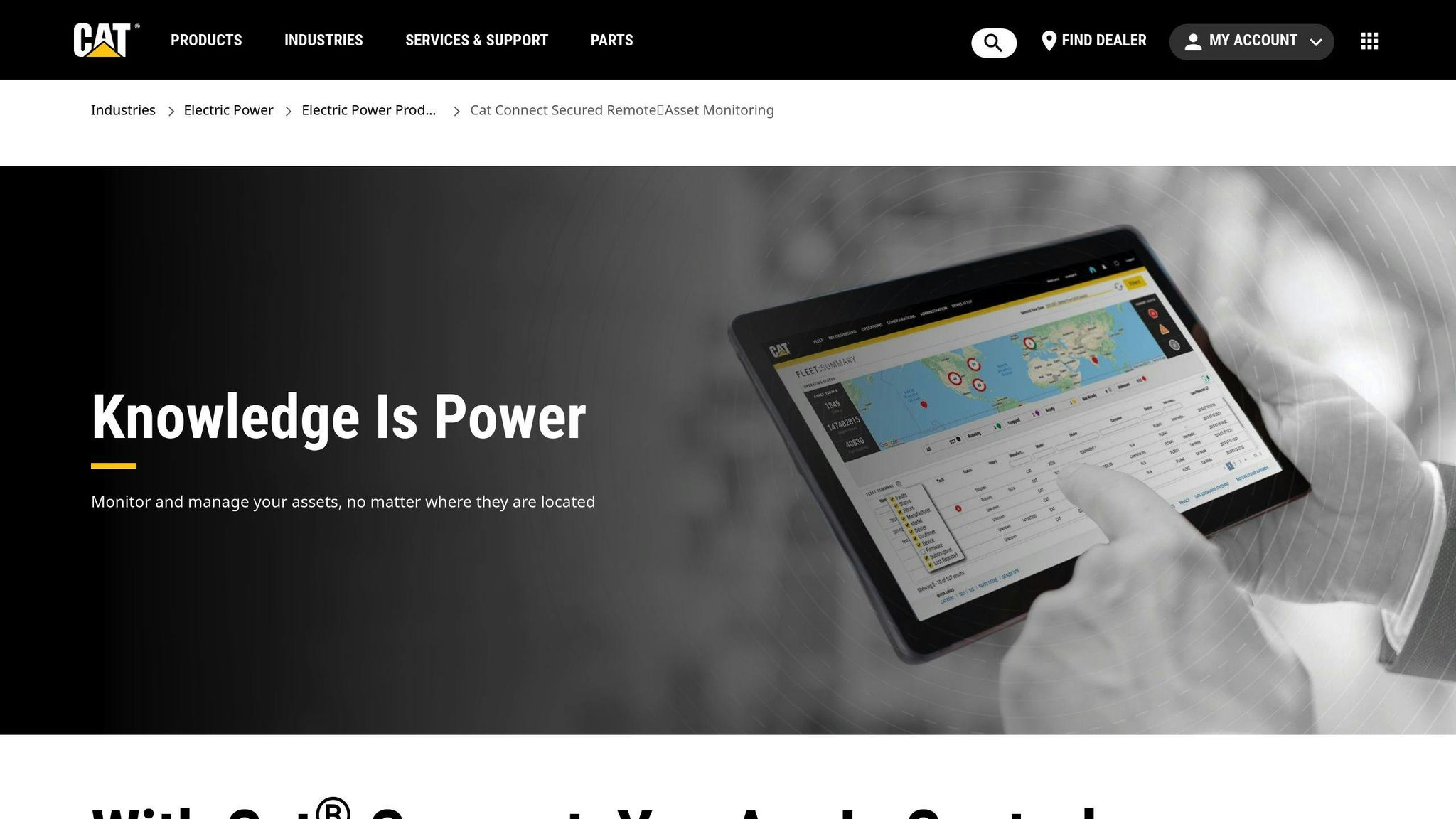IoT Energy Management: Guide, Benefits & Use Cases 2024
IoT energy management uses connected devices to monitor and control energy use in real-time. Here's what you need to know:
- Helps manufacturers cut costs and boost efficiency
- Market expected to reach $222.56 billion by 2030
- 77% of utility companies already using IoT
Key benefits: • Up to 41% reduction in energy use • 30% cost savings in some facilities • Catch and fix issues early
How it works:
- Sensors collect real-time data
- Analytics spot trends and problems
- Automated controls optimize energy use
| Feature | Impact |
|---|---|
| Real-time monitoring | Instant insights into energy use |
| Predictive maintenance | Up to 50% less downtime |
| Automated controls | Dynamic adjustments to save power |
| Integration with renewables | Lower carbon footprint |
Getting started:
- Assess your needs
- Choose compatible sensors
- Set up data collection and analysis
- Start small and scale up
IoT energy management is becoming essential for competitive, sustainable manufacturing in 2024 and beyond.
Related video from YouTube
How IoT Works in Energy Management
IoT is shaking up energy management in factories. Here's the lowdown on these systems and what they can do for you.
Main Parts of IoT Systems
IoT energy management systems have four key parts:
- Sensors: These grab real-time data on energy use, temperature, and how equipment's running.
- Connectivity: Networks that let devices chat with each other.
- Data processing: Number-crunching systems that spot patterns.
- User interface: Dashboards or apps that show you what's up.
How IoT Collects and Uses Data
IoT devices are data-hungry, giving you a clear picture of your energy use. Here's the scoop:
- Sensors track energy use non-stop
- Data zips to a central system for analysis
- Software finds trends and flags issues
- You get alerts and reports to guide decisions
Take GE. They slashed energy use by 25% in their factories with IoT. They could pinpoint power waste and fix it fast.
Adding IoT to Current Systems
Want to upgrade your factory with IoT? You don't need to start from scratch. Here's how to mix IoT with what you've got:
1. Check compatibility: Make sure new IoT gadgets play nice with your current setup.
2. Start small: Kick off with one area, like lighting or HVAC.
3. Use middleware: This software helps old and new systems get along.
4. Train your team: Get everyone up to speed on the new tools.
5. Keep it secure: Lock down your data with strong security.
Walmart's a prime example. They added IoT to manage lighting, refrigeration, and HVAC in their stores. The payoff? Over $1 billion saved in energy costs.
| Before IoT | After IoT |
|---|---|
| Manual readings | Real-time data |
| Reactive fixes | Predictive maintenance |
| Fixed schedules | Dynamic adjustments |
| Estimated usage | Precise measurements |
Benefits of IoT Energy Management
IoT energy management packs a punch for manufacturers. Here's the lowdown:
Better Energy Efficiency
IoT slashes energy waste. How? By showing you exactly where power's going.
The U.S. General Services Administration found buildings with IoT energy systems cut energy use by 41%. That's huge.
Lower Costs and ROI
Less energy = more savings. Simple math.
IBM cut data center energy costs by 30% with real-time monitoring. Money back in their pocket.
| Benefit | Impact |
|---|---|
| Energy savings | Up to 41% reduction |
| Cost reduction | 30% in data centers |
| ROI timeframe | Often within 1-2 years |
Smaller Environmental Impact
Green isn't just PR. It's smart business. IoT shrinks your carbon footprint.
Those GSA buildings? They slashed carbon emissions by 3,100 metric tons yearly. Like taking 674 cars off the road.
Catch Problems Early
Spot issues before they cost you. IoT sensors are your early warning system.
"Continuous energy monitoring can cut energy use by 10-20% when paired with active control and operational tweaks." - American Society of Heating, Refrigerating and Air-Conditioning Engineers
Real-Time Monitoring and Control
See what's happening NOW, not last month. Adjust on the fly.
Oklahoma Gas & Electric uses IoT to watch how customers react to price changes. This helps manage demand in real-time.
IoT puts you in charge of your energy use. Save money, help the planet, keep operations smooth. It's a triple win.
IoT Energy Management Examples in Manufacturing
IoT is shaking up factory energy use. Here's how:
Smart Factory Energy Use
Siemens uses "digital twins" of their factories. These virtual copies help:
- Cut production times
- Lower costs
- Boost quality
Real-time energy tracking lets Siemens spot waste and fix it fast.
Production Line Energy Monitoring
Bosch's smart factories use sensors everywhere. This helps:
- Optimize energy use
- Improve quality
- Boost safety
Result? Faster, more efficient car part production.
Energy Distribution in Large Factories
Newmont Corporation, the top gold miner, added "ventilation-on-demand" at their Eleonore mine:
| Area | Energy Savings |
|---|---|
| Underground | 50% |
| Surface | 73% |
Bonus: Better air for workers.
Using Renewable Energy with IoT
IoT helps factories go green:
1. Solar + Smart Tech
- Tracks solar output
- Matches factory power use to sunny days
- Stores extra energy
2. Wind Power Management
- Predicts wind patterns
- Balances wind with other sources
- Keeps energy supply steady
3. Real-Time Adjustments
Shifts to renewables when they're available, cutting fossil fuel use.
Putting It All Together
General Electric (GE) shows how it's done:
- Uses IoT for predictive maintenance
- Saved billions in upkeep costs
- Made aircraft engines safer and more reliable
GE watches energy use and machine health, keeping production smooth with less power.
Bottom line? IoT turns energy management into a science. Manufacturers get lower bills, greener ops, and smoother production.
Setting Up IoT Energy Management Systems
Here's how to set up IoT for energy management in manufacturing:
Step-by-Step Setup Guide
1. Assess Your Needs
Figure out where you're using energy and where you can cut back. This helps you pick the right IoT gear.
2. Select IoT Devices
Choose sensors that fit your needs. For example:
| Sensor Type | Use Case |
|---|---|
| Temperature | HVAC optimization |
| Current | Power consumption monitoring |
| Motion | Lighting control |
3. Install and Connect Devices
Put sensors in the right spots and hook them up to your network. Make sure they play nice with your existing setup.
4. Set Up Data Collection
Get your IoT platform ready to grab and store data from all your connected devices.
5. Implement Analytics
Use tools to make sense of all that data you're collecting.
6. Optimize and Automate
Use what you've learned to set up automatic responses and tweaks.
Choosing IoT Devices and Sensors
When picking IoT hardware, think about:
- Will it work with what you already have?
- Can it handle tough factory conditions?
- Is it accurate enough for what you need?
- How long will the batteries last, or does it need to be plugged in?
Data Collection and Analysis Methods
To make the most of your data:
- Use edge computing for stuff you need to know NOW.
- Store long-term data in the cloud for later analysis.
- Set up alerts for when energy use looks weird.
Connecting IoT with Existing Systems
Mixing old and new tech can be tricky. Here's how:
- Use IoT gateways to connect old and new systems.
- Update software so everything can talk to each other.
- Consider slapping IoT sensors on your older equipment.
"The payback for installing temperature and humidity sensors on the factory floor was less than one day." - NCD Industrial IoT Case Study
That's a FAST return on investment, showing just how powerful good IoT solutions can be.
Solving IoT Energy Management Problems
IoT energy management is great, but it's not all smooth sailing. Let's tackle some common headaches:
Data Security: Don't Let the Bad Guys In
IoT systems are data goldmines. Hackers love 'em. Here's how to keep your info safe:
- Encrypt EVERYTHING
- Use multi-factor authentication
- Update, update, update
Remember the 2016 Mirai botnet attack? It turned unsecured IoT devices into website-crushing zombies. Don't let that be you.
Data Overload: Taming the Information Tsunami
IoT sensors spew data like a firehose. Here's how to stay afloat:
- Edge computing for quick decisions
- Compress data to save space
- Cloud storage for the long haul
Playing Nice: Making IoT Systems Talk to Each Other
Getting IoT devices to communicate can be like herding cats. Try this:
- Stick to open standards (MQTT, CoAP)
- Use IoT gateways for old-meets-new
- Standardize your data
Money Matters: Keeping Costs in Check
IoT projects can burn through cash. Here's how to keep your wallet happy:
- Start small, prove value
- Work with what you've got
- Consider cloud-based options
| Strategy | Why It's Smart |
|---|---|
| Pilot projects | Test before you invest |
| Use existing tech | Save on new gear |
| Cloud platforms | Ditch expensive hardware |
The US Ski and Snowboard team faced a tech tangle. Their solution? A custom API. It fixed their integration headache and made future tweaks a breeze.
sbb-itb-b5aecec
Future of IoT Energy Management
New Technologies on the Horizon
5G is set to transform IoT energy management in manufacturing. With speeds up to 10 Gbps, it'll enable real-time monitoring and control like never before.
| Technology | Energy Management Impact |
|---|---|
| 5G | Real-time processing and decisions |
| Edge Computing | Less data transmission, lower energy use |
| AI/ML | Smarter energy consumption |
What's Coming After 2024
The IoT energy management market is booming. It's expected to jump from $61.02 billion in 2022 to $222.56 billion by 2030, growing at 17.8% yearly from 2025 to 2030.
Why? Better data tools, personalized energy solutions, and new efficiency regulations are driving this growth.
AI and Machine Learning in IoT
AI and machine learning are game-changers for IoT energy management. They'll help manufacturers:
- Predict energy needs based on production
- Spot and fix energy waste automatically
- Balance renewable and grid power
"AI could cut global emissions by 10-15% by 2030", say industry experts.
Real-world examples show AI's power:
- Octopus Energy (UK) uses AI for smart grids, helping customers use cheaper, greener energy.
- China's State Grid Corporation predicts energy production with AI, adjusting distribution as needed.
- Siemens boosts factory efficiency in Germany with AI-powered automation.
These advances point to a future where IoT and AI team up for smarter, more efficient manufacturing energy systems.
Real-World Examples
Let's look at how some big names in manufacturing are using IoT to save energy and boost efficiency:
GE: Predix Platform

GE's Predix platform is a game-changer:
- IoT sensors across plants
- 20% less equipment downtime
- 15% boost in production efficiency
- $200 million yearly savings on maintenance and operations
Siemens: MindSphere Platform
Siemens' MindSphere platform is no slouch either:
- IoT sensors for energy and machine data
- 12% cut in energy use
- 18% drop in defect rates
Bosch: IoT Gateway

Bosch's IoT Gateway breathed new life into old machines:
- 25% increase in machine uptime
- 20% jump in productivity
- 15% savings on maintenance and operational costs
Caterpillar: Cat Connect

Cat Connect technology revved up equipment performance:
- 30% lower maintenance costs
- 10% less fuel use
- 15% boost in overall efficiency
Making It Work for You
Want to replicate these successes? Here's how:
- Set clear goals (like cutting energy use or boosting uptime)
- Pick the right IoT tools for your needs and budget
- Use your data smartly to spot trends and make good decisions
- Train your team to get the most out of the new tech
- Keep improving - regularly check your system for new ways to save
More Success Stories
| Company | What They Did | The Result |
|---|---|---|
| Newmont Corporation | Installed smart ventilation system | Cut underground ventilation costs by 50%, surface by 73% |
| Rolls-Royce | Used digital twins for engine monitoring | Up to 50% more time between maintenance |
| Husky Injection Molding Systems | Installed submeters to find energy hogs | $160,000 yearly savings by tweaking pump pressure |
These examples show how IoT can lead to big wins in manufacturing. It's not just about saving energy - it's about smarter, more efficient operations across the board.
Conclusion
IoT energy management is changing manufacturing. Here's how:
- It lets you watch and control energy use in real-time
- You get insights from data to make better choices
- It saves money by making things more efficient
- It's better for the environment
IoT is shaking things up in manufacturing:
- Shell uses AI to keep 10,000+ machines running smoothly
- Siemens built a super-connected factory that wastes less
- A telecom company in Taiwan used IoT to cool stores only when needed
Want to use IoT for energy management? Here's what to do:
1. Start small
Try it out in one part of your business first.
2. Go digital
Upgrade your systems to collect and crunch energy data.
3. Lock it down
Make sure your IoT network is safe from threats.
4. Train your people
Your team needs to know how to use and understand IoT.
5. Know what you want
Figure out what you're aiming for with IoT energy management.
| What to do | What you get |
|---|---|
| Use predictive maintenance | Cut downtime by up to 50% |
| Put in smart meters | See energy use as it happens |
| Use digital twins | Test changes before you make them for real |
| Add renewable energy | Lower your carbon footprint and energy bills |
FAQs
What is smart energy management using IoT?
Smart energy management with IoT tracks and controls building energy use. It uses sensors to measure:
- Air temperature
- Humidity
- Lighting levels
These systems adjust energy use in different building areas, saving power and money.
What is energy management in IoT?
IoT energy management plans and controls energy use across industries. It:
- Collects data from connected devices
- Analyzes data to find energy-saving opportunities
- Automatically adjusts systems to cut power use
Does IoT decrease energy efficiency?
No, IoT BOOSTS energy efficiency. Here's how:
| Benefit | Impact |
|---|---|
| Energy savings | Can cut electricity use by 1.6 petawatt-hours by 2030 |
| Home power | Savings equal to powering 150 million homes for a year |
| Cost reduction | Can lower energy bills by 10-15% in smart homes |
Real-world examples show big savings:
Walmart saved over $1 billion in energy costs using IoT to manage lighting, refrigeration, and HVAC.
General Electric cut energy use by 25% in their factories with IoT systems.
IoT helps companies slash energy use while meeting their needs. It's a game-changer for making industries more efficient.